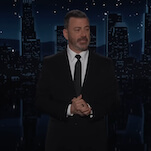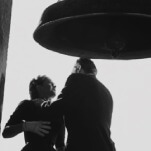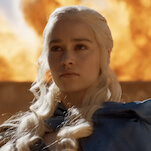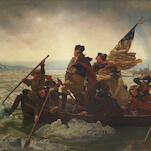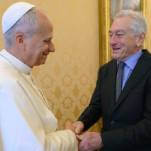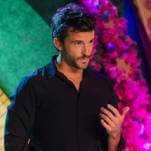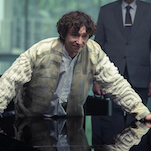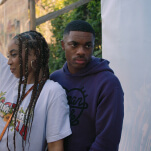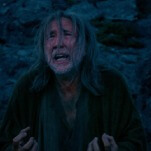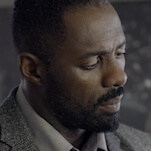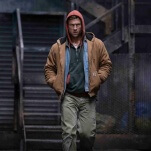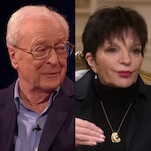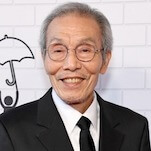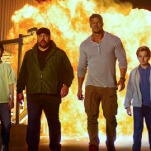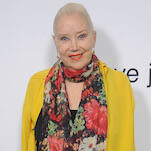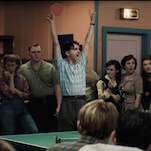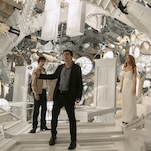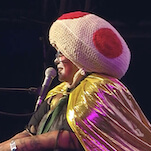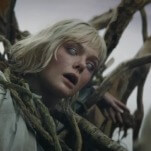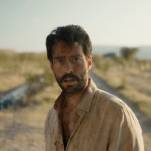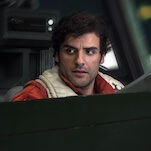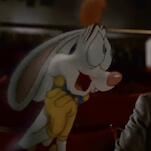Each week, Big Issues focuses on a newly released comic book of significance. This week, it’s The Punisher #15. Written by Becky Cloonan (By Chance Or Providence, Southern Cross) with art by Matt Horak (The Covenant, Octo Skull) and colorist Lee Loughridge (By Chance Or Providence, Southern Cross), this self-contained issue completes a short-story cycle accentuating different facets of both the character and the creative team. This review reveals major plot points.
The single-issue story is a challenge in a superhero comics industry driven by the serialization of longer arcs. It’s hard to tell a complete, satisfying story in only 20 pages, but the last three issues of The Punisher have made it look easy. Writer Becky Cloonan’s first year on The Punisher took Frank out of New York City for a story that spanned 12 thrilling issues, but Cloonan has dramatically changed the storytelling for Frank’s homecoming. #13-15 are a trio of short stories, each presenting new opportunities for punishment while highlighting the versatility and ambition of this creative team as it plays with tone, pacing, composition, layout, and color.
I recently read Cloonan and Lee Loughridge’s exceptional By Chance Or Providence, a collection of three beautiful short stories that juggle horror and romance in a medieval setting, so I decided to reread the three most recent issues of The Punisher in one sitting and see how they work as a short-story cycle. Taken together, they provide a comprehensive character study that highlights different aspects of Frank’s personality, his relationship to the Punisher identity, and where his responsibilities lie when he has so much power (specifically firepower). They also each have a distinct visual sensibility. Guest artist Kris Anka and colorist Matthew Wilson bring an exhilarating manga-esque energy to #13, #14 is a brilliant exploration of how color and layout dictate the rhythm of a story, and #15 takes extreme inspiration from the cover for its interiors, which shift between pen and brush inking to distinguish actual events from recorded footage.
As an artist herself, Cloonan understands how much power the visuals have in comic-book storytelling, and the artwork carries a lot of the weight when it comes to Frank’s emotional life. On the surface, Frank Castle is alone, but content. He knows his purpose in life, and he’s happy to be back home, doing what he does best. Being holed away in a sewer with all his guns and his cameras is a cold, creepy living situation, but it allows Frank to act as efficiently as he can. He doesn’t give off the vibe that he’s a lonely person, but the visuals suggest that he’s living with a deeper spiritual loneliness.
In this week’s The Punisher #15, there are square panels of black-and-white surveillance footage sprinkled throughout the pages, showing the action from the fixed, unemotional perspective of a camera. The first time these square panels touch is the moment when Frank investigates the death of a woman pushed onto the train tracks, and the first panel has Frank standing completely alone. The panel directly underneath shows a large group of people gathered around the bench that has become a memorial for the victim, and the juxtaposition of those two images reinforces Frank’s solitude while also drawing attention to the mass of scared, grieving people that Frank fights to protect.
The concept of responsibility is explored through three lenses in each issue: The Punisher #13 looks at his responsibility to his neighborhood as he finds out that one of his own guns landed in the hands of a kid. On first read, it seems like Frank is angry that he was robbed, but knowing about the gun’s second safety changes Frank’s initial reaction to the theft. If that kid tries to shoot that gun, he’s going to lose a hand, and Frank would be responsible because he didn’t properly lock away his arsenal. He holds himself accountable for anything that happens with that gun, and when he tracks the gun down to a frightened mother being abused by her son’s father, he needs to get involved in their conflict to make sure she doesn’t get hurt.
The responsibility expands in The Punisher #14, which has Frank disrupting a museum robbery during a citywide blackout. He’s in urban-protector mode here, and he immediately jumps into action when he hears a woman scream for help, offering his freshly made, fully loaded hot dog to a homeless man on the way. The thieves each get their punishment, but Frank saves the worst for the man at the electric company who triggered the blackout and put an entire city at risk. In these first two chapters, responsibility is linked to violent action, but that changes in The Punisher #15 when Frank serves his country by helping one of the men who fought for it.
While chasing a criminal who has been pushing strangers into oncoming subway trains, Frank is helped by a homeless veteran who navigates him through the underground community. Frank is able to tell that this is a man with military experience (he even successfully names his rank), and when the man begins to pity himself, Frank reminds him that he still has a life and he can be doing something good with it. The two of them team up, which is a big deal after the previous two stories emphasized how isolated Frank is from other people. Frank disappears after their mission is done and lets Ryan take the credit for being the hero, and the issue ends with Frank raising his coffee mug to Ryan on the television, smiling as he leans back and props his feet up to reveal slippers with white skulls on the bottom.
The teaser for Netflix’s upcoming The Punisher series debuted at the end of The Defenders, and it looks like a very serious, very dark, and very sad look at Frank’s military trauma, his past with his dead family, and his current mission to kill criminals. There are definitely serious moments in Cloonan’s run on The Punisher, but she takes a cue from Punisher veteran Garth Ennis and includes moments of humor that provide necessary contrast for a character who is so dark at his core. In The Punisher #15, we see an especially rare emotion for Frank: joy. He’s delighted to have a partner in this fight, and when the veteran asks Frank what people call him, he grins wildly as he says, “The Punisher.” Frank loves what he does, and this issue gives a strong sense of that affection for his work while still showing that his work is terrifying and brutal. The Punisher is a frightening person, and seeing the calm satisfaction he finds in murder makes him even scarier.
Declan Shalvey and Jordie Bellaire’s covers for The Punisher are some of the best in superhero comics, distilling an entire issue into a single striking image that sets the tone for what’s to come. The illustrations aren’t necessarily moments that actually appear in the story; they’re often more symbolic, or a heightened visual representation of specific themes. And they always have The Punisher’s signature skull. Shalvey has incorporated the skull into every single one of his cover compositions, and it introduces a design challenge that forces him and Bellaire to think outside the box with these images.
Darkness is especially prevalent in these three most recent covers to make the skulls pop: For issue #13, a huge chunk of negative space surrounds Frank as he walks out of a subway station while the lights of a skyscraper form a skull. The completely blacked-out buildings on the cover of #14 make the shining star-skull more ethereal, while the glowing red skull of the subway wiring on #15 is severe and menacing as it burns through a swath of black. The placement of these skulls also speaks to The Punisher’s fundamental bond to New York City. He isn’t just a part of the city; his spirit is infused in its architecture, its foundation, and even the stars above it.
Issues #14 and #15 don’t have a letters page, and it ends up having an impact on the storytelling because the next month’s cover functions as an extra exclamation point at the end of the issue. You think you’ve reached the end of the road, and then you’re hit with a full page of next month’s cover, which tells its own little story. The covers function so well as individual pieces of art that they’re like bonus illustrations at the end of the issue, and in the case of #15, the image published at the end of #14 is actually better than the actual cover.
The composition of this week’s cover introduces some problems with all the Marvel trade dress, and putting the action at the top and bottom of the page forces the bar code, logo, and credits to the center of the page. The bar code is the real problem here, and that big block of white in what should be an all-black space throws off the balance of the image. It’s still a great cover, and one of the coolest things about The Punisher is how Matt Horak takes specific cues from the cover to dictate his storytelling for that issue. In the case of The Punisher #15, the long, thin panels of action on the cover inspire him to use long, thin panels for the majority of his layouts, usually using five on a page so that they’re even slimmer.
Because covers are completed before the interior artwork for the issue is completed (or even started), they can influence how the artist approaches the issue. This is certainly the case with Horak, who carries visual motifs from the cover to the interiors. With issue #14, the big splash page of the blackout is tied to the cover with its speckled sky of stars, and the contrast of light and dark in Shalvey and Bellaire’s image is intensified by Horak’s work with Lee Loughridge, who replaces Frank Martin as the new ongoing colorist. (Martin is an outstanding colorist, but Horak’s linework hits harder when paired with Loughridge’s flatter rendering and heightened color contrasts.) #15 has the pinnacle of this relationship between cover and interiors, with Horak incorporating the skull motif that has been a constant in Shalvey’s work. The skull appears in the massive blood splatter left in the wake of a train crashing into Frank’s target, and Horak’s composition uses the skull’s shape to add an explosive quality to the panel with the teeth spraying out from the point of impact.
Earlier this week, Marvel announced that The Punisher would be getting a new creative team for the upcoming Marvel Legacy initiative. Writer Matthew Rosenberg and artist Guiu Vilanova are putting Frank Castle in the War Machine armor starting with November’s The Punisher #218, and the tone is going to shift considerably as Frank assumes a more prominent superhero role. This current run of The Punisher is an action thriller with deep roots in the crime genre, and it’s a surprise when there’s a reminder that this is a superhero world, like the Alpha Flight billboard Frank perches on in issue #13. Frank in a suit of high-tech armor completely alters the circumstances for the character, and drastic changes for The Punisher have had varying degrees of success in the past.
With Becky Cloonan leaving The Punisher in October, there will be no women writing solo male superhero titles at any of the major superhero publishers. (By contrast, there are many, many men writing series spotlighting solo heroines.) Lion Forge’s Catalyst Prime line has Alex De Campi writing Astonisher in October, but that’s a new hero who doesn’t have the established fan base of DC and Marvel’s biggest heroes. For decades, the most popular superheroes have been primarily written by cis-het white men, and Becky Cloonan’s The Punisher shows the value of looking outside that group for storytellers. The quality of this series doesn’t come from Becky Cloonan being a woman, it comes from her being a creator that can craft captivating stories with rich visual elements. There’s an ever-growing number of talented creators who could revitalize superhero comics if they had the opportunity to work on these characters, but they’re still being marginalized. That’s part of both DC and Marvel’s legacies, and they haven’t made a significant commitment to break from tradition.

